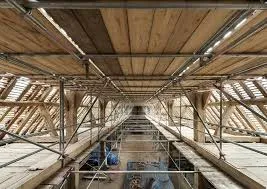Mai . 11, 2024 17:34 Back to list
What is Scaffolding? A Comprehensive Guide
What is Scaffolding? A Comprehensive Guide
What is Scaffolding? : If you’ve ever passed by a construction site, you’ve likely noticed a temporary structure surrounding the building, resembling a skeletal framework. This structure, known as scaffolding, plays a pivotal role in construction and various other industries. In this article, we’ll dive deep into what scaffolding is, its types, uses, safety measures, and its importance in different fields.
Introduction to Scaffolding
Scaffolding, in essence, is a temporary structure erected to support workers, tools, and materials during construction, maintenance, or repair activities. It provides a safe and accessible platform, allowing workers to reach heights that would otherwise be challenging.
Different Types of Scaffolding
Single-Frame Scaffolding
Single-frame scaffolding, also known as bricklayer’s scaffolding, consists of a single frame of standards connected by ledgers. It’s commonly used for brickwork and masonry repairs.
Double-Frame Scaffolding
Double-frame scaffolding offers greater stability and strength by utilizing two frames of standards. This type is suitable for heavy construction tasks.
Suspended Scaffolding
Suspended scaffolding is suspended from a building’s rooftop by ropes or chains. It’s often used for tasks like window cleaning and painting high-rise buildings.
Cantilever Scaffolding
Cantilever scaffolding employs horizontal projections to support the working platform. It’s ideal for situations where the structure cannot bear the load of standard scaffolding.
Mobile Scaffolding
Mobile scaffolding is mounted on wheels, allowing for easy mobility. It’s convenient for projects that require frequently changing work locations.
Components of Scaffolding
Standards
Standards are vertical tubes that form the main framework of the scaffold. They provide vertical support and stability.
Ledgers
Ledgers are horizontal tubes connected to the standards, offering horizontal support to the scaffolding structure.
Transoms
Transoms are placed horizontally and connect ledgers, increasing the stability and load-bearing capacity of the scaffold.
Base Plates and Sole Plates
Base plates distribute the load evenly on the ground, while sole plates prevent the scaffold from sinking into the ground.
Braces
Braces diagonally connect standards and prevent lateral movement of the scaffold, enhancing its stability.
Ringlock Scaffolding System
Importance of Scaffolding in Construction
Scaffolding holds immense significance in the construction industry for several reasons:
Accessibility
Scaffolds provide easy access to higher areas of construction, allowing workers to perform tasks efficiently.
Safety and Protection
Scaffolding ensures the safety of workers by offering stable platforms and fall protection systems, reducing the risk of accidents.
Efficient Workflow
With scaffolding in place, workers can focus on their tasks without worrying about accessing hard-to-reach areas, leading to increased productivity.
Scaffolding in Other Industries
Scaffolding isn’t limited to construction; it’s also widely used in various other industries:
Film and Entertainment
In the entertainment industry, scaffolding is used to build sets, stages, and lighting structures for film shoots, concerts, and events.
Maintenance and Renovation
During maintenance and renovation projects, scaffolding provides a safe platform for workers to repair and upgrade buildings.
Ensuring Safety on Scaffolds
Maintaining safety on scaffolds is paramount:
Regular Inspection
Scaffolds should undergo routine inspections to identify and address any structural issues promptly.
Proper Training
Workers should receive proper training on scaffold usage, assembly, and safety protocols.
Fall Protection Systems
Installing guardrails, safety nets, and personal fall arrest systems minimizes the risk of falls.
Environmental Impact of Scaffolding
Scaffolding’s environmental impact should be considered:
Material Sustainability
Using sustainable materials for scaffolding can reduce its ecological footprint.
Energy Consumption
Innovations like energy-efficient lighting on scaffolds can minimize energy consumption on construction sites.
Advancements in Scaffolding Technology
Technology is shaping the future of scaffolding:
Modular Scaffolding Systems
Modular systems allow for quicker assembly and adaptability, enhancing efficiency.
Digital Scaffolding Solutions
Digital tools aid in planning and monitoring scaffolding projects, streamlining the process.
Scaffolding Regulations and Standards
Scaffolding is subject to regulations and standards:
OSHA Guidelines
The Occupational Safety and Health Administration provides guidelines to ensure scaffold safety.
ANSI/ASSE A10.8 Standard
This standard outlines safety requirements for scaffolding in the construction industry.
Conclusion
Scaffolding stands as an essential element in construction, offering access, safety, and efficiency. Beyond its traditional role, it finds applications in diverse industries, shaping the way we build and create. By adhering to safety standards and embracing technological advancements, we ensure a safer and more sustainable scaffolded future.
-
China Single Sided Wall Formwork: AI-Optimized Solutions
NewsAug.02,2025
-
H20 Timber Beam Enhanced with GPT-4-Turbo AI Design
NewsAug.01,2025
-
Premium Timber Beam H20 | Strong & Durable Construction
NewsJul.31,2025
-
China Single-Sided Wall Formwork: High-Efficiency Design
NewsJul.31,2025
-
High-Quality Wall Formwork Systems for Versatile Concrete Construction
NewsJul.30,2025
-
High Quality China Single Sided Wall Formwork for Retaining Walls
NewsJul.30,2025
